Venus Flytrap soil and potting techniques
Can’t find the proper ingredients to mix your own soil? Buy Venus flytrap potting soil or New Zealand Long Fiber Sphagnum.
It is very important to use nutrient-poor soil to grow Venus Flytraps. Regular potting soil or enriched soil will burn the roots and kill your Venus flytrap very quickly. We do not recommend fertilizing Venus flytraps. The fertilizer can burn the roots and likely kill the plant.
Some expert growers use extremely diluted fertilizer. In most cases, fertilizer is applied only to the leaves of the plant. This is risky and not recommended for a novice grower. It is best to simply allow your Venus flytrap to catch food on its own. It can also be fed mealworms or other insects.
Venus flytraps prefer growing in a sphagnum-based soil mix. Perhaps the easiest medium to use is simply pure, unenriched (NO Miracle-Gro!) peat moss or long-fiber sphagnum moss. Most retailers that carry potting soil sell large bales of peat moss.
The most widely accepted medium to use when potting Venus flytraps is a 1:1 mix (in terms of volume) of peat and perlite. When choosing a brand of peat moss, any type will do as long as it isn’t enriched.
Avoid soil with fertilizers
Be sure to avoid peat moss brands like Miracle-Gro and Scott’s. They contain fertilizer that will kill your flytrap.
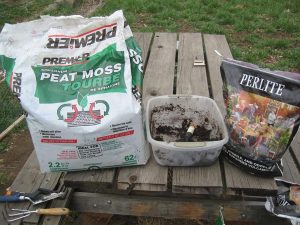
Perlite is also relatively easily found at large department and hardware stores, or at your local nursery. Perlite provides aeration and optimum moisture retention. Many people substitute silica or horticultural sand for perlite.
A 1:1 mix of peat and perlite is commonly referred to as the “standard” CP (carnivorous plant) mix because most carnivorous plants grow well in this medium. Many growers like to use the standard CP mix and then top it off of long-fibered sphagnum moss. This prevents the perlite from floating to the top. When exposed to heavy rains, perlite has a strong tendency to float to the top of the soil.
Our preferred mixture of soil for Venus flytraps is five parts peat moss, three parts silica sand, and two parts perlite by volume. The silica sand really helps with aeration and the formation of a very healthy root system. Silica is a very hard mineral that is not soluble and is completely neutral and inert. This makes it perfect for carnivorous plants because it will not release any minerals into the soil.
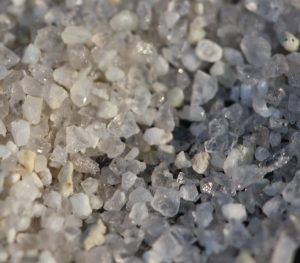
Mixing the soil
Choose an adequately large container that will allow you to mix the peat and perlite without spilling it. A five-gallon bucket works well.
Add peat moss to the mixing container.
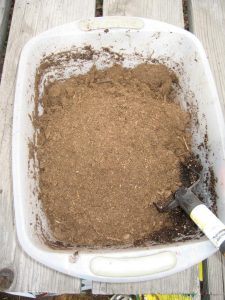
Then add the perlite.
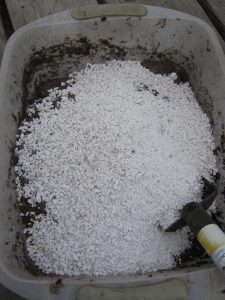
Lastly, add some distilled water and mix.
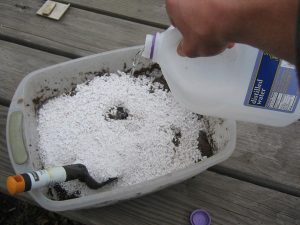
Add a lot of water to the mix because the peat moss can hold much water. Continue adding water and stirring the mix together until the peat moss is soaked and the perlite is well mixed in. Peat moss has a tendency to repel water initially, especially if it is cold. However, it will eventually start soaking up the water. Ultimately, you should end up with something that looks like this:
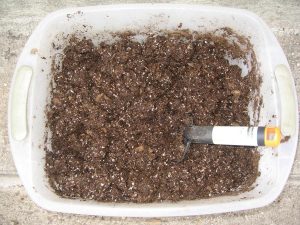
Choosing a pot for your Venus flytrap
Choosing the right pot for your Venus flytrap is an important process. It can mean the difference between a small plant that struggles most of its life and a large, robust, healthy plant that flowers to produce a lot of seed and divides regularly.
Venus flytraps prefer to have a pot with good vertical depth so that their roots have room to grow. Venus flytraps can be grown in anything from short 2-inch pots all the way up to pots as big as they come. Pots between 4 inches and 5 inches in depth are most commonly used. But in general, the deeper the pot, the better it will be for your pet Venus flytrap.
Another important characteristic of a good Venus flytrap pot, especially in climates with more extreme temperatures, is good insulation. An insulated pot will provide a stable temperature for the roots. Insulated pots also prevent the soil from heating when sunlight directly hits the sides of the pot. It will also provide a bit of protection from the soil freezing when the temperatures dip just below freezing.
Commonly used Venus flytrap pots
Plastic pots are easy to find, cheap and will work well for Venus flytraps. However, most plastic pots are dark in color and therefore absorb heat. Given the fact that they aren’t insulated, the soil temperature can rise and fall quickly in the pot. Having said that, I’ve used these pots successfully and my plants did well. But when I made the switch to insulated pots, the difference in their health was noticeable.
Insulated foam beverage cups or styrofoam cups work well and are in inexpensive choice for a pot. They’re white, so they don’t heat up much in direct sunlight. Choose cups that are 16 ounces or more. They provide excellent insulation for the roots of the Venus flytrap. At over 4.5″ tall, they provide good vertical space for your Venus flytrap to develop a healthy root system. To top it off, you can purchase twenty of them for one dollar, so the price is right!
How to repot a Venus flytrap
Repotting a Venus flytrap is actually quite an easy process. The basic procedure is to remove the plant from its current container, remove the soil from its roots, and pot it in its new container. Below you will find a detailed step-by-step procedure of how to accomplish this task. Our instructions cause a minimal amount of stress so that your Venus flytrap can quickly recover and resume growing. Begin by finding a good work area where you can make a mess. An outside picnic table or workbench is perfect.
One term that you’ll need to know before we start is rhizome. The rhizome of your plant is the white bulb-like part that’s just below the soil, but above the black roots. It’s the area that all of the leaves on your Venus flytrap originate from and where the plant stores energy. With that term defined, let’s get started!
Step 1) Preparing the new pot
Once you’ve prepared your desired soil mix as described above and it’s moistened all the way through, simply fill the chosen pot with the soil mix and gently compress it. Using a stick, screwdriver, your finger or some other tool, make a fairly deep hole for the roots and rhizome of the plant to go into. Make the hole deep enough to accommodate the roots with minimal winding. Be sure to make the top a bit wider than the bottom so that you have plenty of room for the rhizome.
Step 2) Uprooting the plant
Release the soil from the current pot by gently squeezing the sides of the pot. Then slowly turn the pot over with one hand while placing your second hand under the pot to guide the ball of soil and plants out of the pot. Once you have the old soil and plants free from the original pot, start breaking away the soil from the roots. Do this very gently and methodically to be sure not to tear or otherwise damage any of the roots. You can also simply dunk the entire soil ball into clean water (rain, reverse osmosis or distilled water) and swirl it around to release the soil.
Step 3) Guide the roots into the new pot
Hold the rhizome of your plant in one hand. With your other hand, use the tool of choice (screwdriver, stick, finger, etc.) to guide the roots of your Venus flytrap down into the hole in the soil of the new pot that you made in step one. Try to get the roots as straight and deep as possible into the new pot. Work them all the way down until the rhizome is setting just below the surface of the soil in the hole you created.
Step 4) Press the soil in around the rhizome and roots
Once your Venus flytrap is placed down far enough in the soil with its roots deep into the pot, start pushing soil in around the rhizome. Sometimes it’s easier to use extra soil from your mix to drop into the hole. In whatever way is easiest, fill dirt in around the roots and rhizome thoroughly. Then gently press soil in around the sides of the rhizome to make sure that it’s seated well into the soil. Do not plant the Venus flytrap too deeply in the soil, but make sure that the white part of the rhizome is completely covered.
Step 5) Water the venus flytrap thoroughly
Watering the Venus flytrap after repotting will help ease the root shock. It also helps the soil to settle and remove air pockets. Slowly water from the top to avoid the perlite and silica sand from coming to the top of the soil. Gently pour the water directly on the plant itself to avoid disturbing the soil. Water until the soil is thoroughly soaked through.
If you have any more questions, be sure to read the Venus flytrap Soil FAQs.

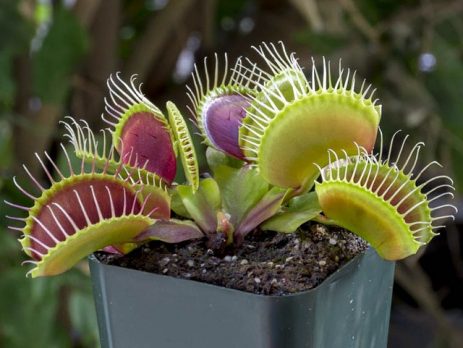
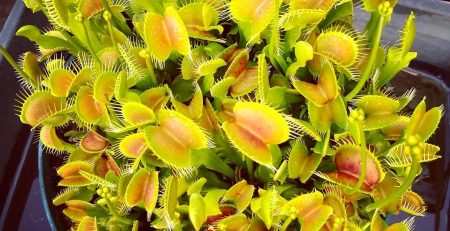
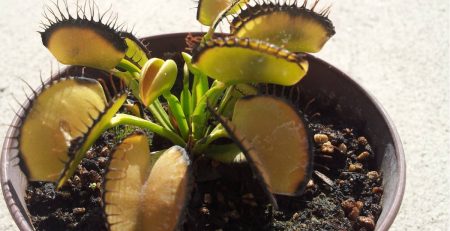
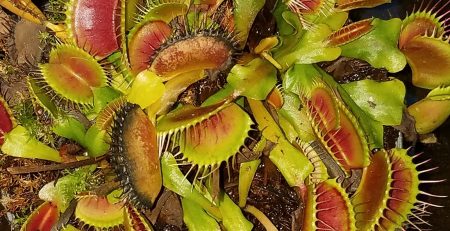
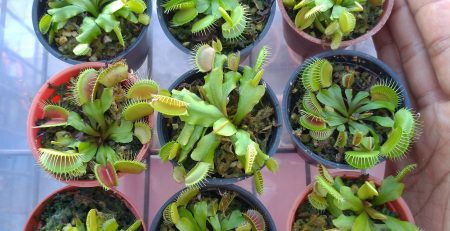
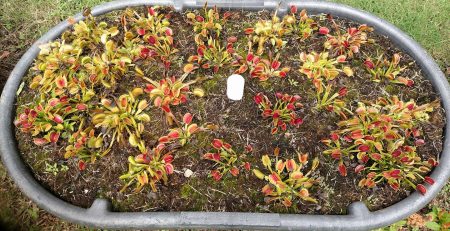
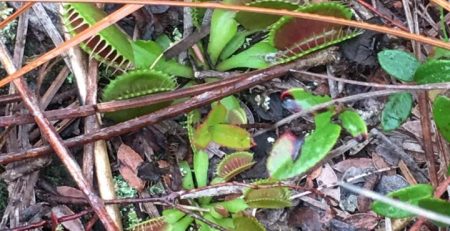
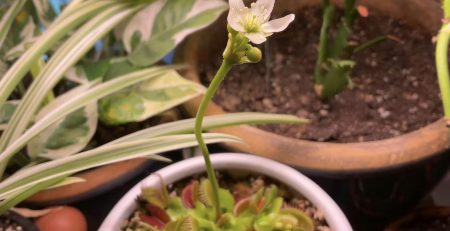
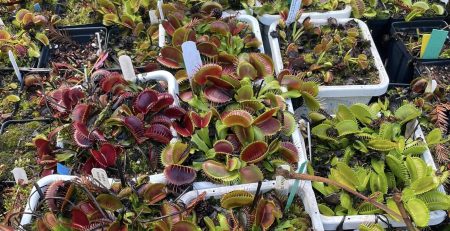
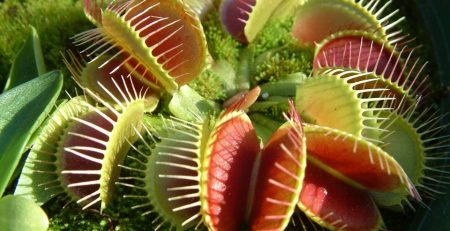
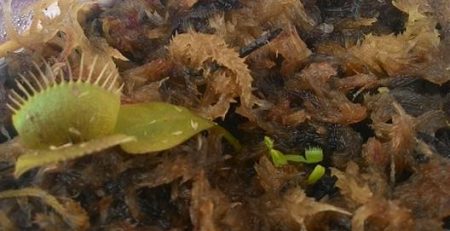
Leave a Reply
You must be logged in to post a comment.